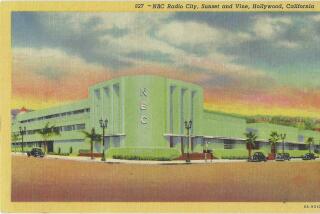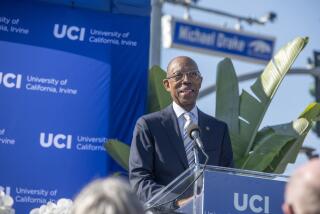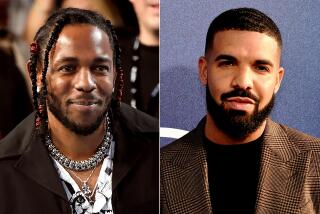Bill Drake dies at 71; ‘Boss Radio’ inventor spread less-talk format across country
- Share via
Bill Drake, the legendary radio programmer who revamped Top 40 radio in the 1960s and helped launch highly successful “93/KHJ Boss Radio” in Los Angeles, has died. He was 71.
Drake died of lung cancer Saturday at West Hills Hospital and Medical Center in the San Fernando Valley, said Carole Scott, his domestic partner.
In the ‘60s, Drake was known as one of the most powerful men in the radio industry. His formula for success was called the Drake format: less talk, fewer commercials and more music.
Drake-Chenault Enterprises, the national radio consulting service that he ran with business partner Gene Chenault, monitored the programming for stations from coast to coast, sweeping “most of the competition away like so much dust,” according to a 1974 article in The Times.
“What he did for American radio, particularly the Top 40 format, was to clean up all the clutter, such as disc jockeys rambling on and on forever,” said John Long, president of the Georgia Radio Hall of Fame, which inducted Drake in 2007.
“He tightened down the format by controlling when they talked and how much they talked and, to some degree, what they said,” Long said. “He chose to make the music the star, and selected the most popular music of the day and put it in a rotation so that a listener could hear his or her favorite song more frequently.”
In Los Angeles, what Time magazine in 1968 called the “Drake style” was evident on KHJ-AM (930).
When the RKO-owned radio station debuted its new format in 1965, according to a Times article, it attracted less than 2% of the Los Angeles radio audience.
Five months later, the station was ranked No. 1, with more than 15% of the radio audience.
But the Drake format was more than just more music and less chatter, said Don Barrett, publisher of LARadio.com.
Boss Radio, he said, had driving personalties such as Robert W. Morgan and the Real Don Steele, who “were able to take this format to new heights that had never been achieved before in the marketplace.”
The successful Drake format, said Barrett, “was launched in city after city and became a huge success in Boston, San Francisco and the Detroit market. And there were a lot of copycats where he was not involved.”
When Time magazine caught up with Drake in 1968, he was running his “multimillion-dollar radio consulting service” out of his home in Bel-Air and had a string of rating successes behind him.
In San Diego, radio station KGB-AM had soared from being No. 14 to No. 1 three months after Drake-Chenault came on board as consultants in 1964.
The RKO-owned San Francisco station KFRC-AM also had gone to No. 1 in a number of months. And WOR-FM in Manhattan, N.Y., doubled its rating in 11 months and propelled the money-losing station into the black.
“Once new jocks are hired,” Time noted, “they are drilled for a couple of months in the Drake style. The big idea is to unclutter and speed up the pace. The next recording is introduced during the fade-out of the last one.”
Singing station identifications, the magazine said, were shortened to mere seconds, and commercial breaks were reduced to 13 minutes and 40 seconds an hour -- about a third less than the U.S. average.
Newscasts were scheduled at unconventional times so that when competing stations were airing the news, “Drake-trained deejays” lure dial-switching listeners with a “music sweep” of three or four back-to-back songs.
Drake told the magazine that he considered music selection one of his key services.
Drake, his record librarian or a panel of 24 “proteges” at his stations around the country would audition almost every new U.S. release and follow up with a weekly phone call with each station to discuss what new prospective hits to add to the playlist.
Drake monitored his far-flung client stations via a custom telephone hookup. And if he heard something he didn’t like, he picked up the phone. (In those pre-cellphone days, he had 21 phones in his house, including one in each of the five bathrooms.)
“When that phone rings,” one disc jockey told Time, “you know it’s death time, man.”
Born Philip Yarbrough on Jan. 14, 1937, Drake grew up in Donalsonville, Ga., and launched his radio career at WMGR in nearby Bainbridge while still in high school.
He attended Georgia Southern University in Statesboro on a basketball scholarship, according to his website, and moved to Atlanta in the late ‘50s to work as a disc jockey -- and later program director -- at WAKE. He changed his name to Drake, he later said, because the station wanted a name that rhymed with its call letters.
In 1961, Drake moved to San Francisco as program director of KYA, which became the city’s top station. The following year he became program director at KYNO in Fresno and KSTN in Stockton, both of which became No. 1 stations.
By the early ‘70s, according to Drake’s website, Drake-Chenault was offering sales and programming consulting services, including jingles performed by the Johnny Mann Singers and totally automated packages in six different formats, with more than 350 full-time radio stations.
The firm’s special features division produced a syndicated 48-hour radio special, “The History of Rock and Roll,” in 1969. A rewritten and updated 52-hour version, which Drake narrated, aired in 1978 on more than 400 radio stations.
Drake sold his interest in Drake-Chenault Enterprises in 1983, but Scott said he was developing a new Top 40 format for satellite radio before his death.
Drake was married and divorced three times. In addition to Scott, Drake is survived by his daughter, Kristie Philbin; and three grandchildren. Instead of flowers, donations may be made to the American Cancer Society.
McLellan is a Times staff writer.
More to Read
Sign up for Essential California
The most important California stories and recommendations in your inbox every morning.
You may occasionally receive promotional content from the Los Angeles Times.









